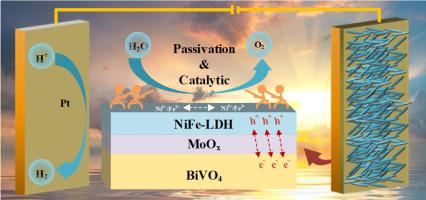Journal of Colloid and Interface Science ( IF 9.4 ) Pub Date : 2022-06-25 , DOI: 10.1016/j.jcis.2022.06.095 Bokai Kang 1 , Muhammad Bilal Hussain 1 , Xingxing Cheng 1 , Chong Peng 2 , Zhiqiang Wang 1

|
Herein, a facile green synthetic protocol for nanoporous NiFe-LDH/MoOx/BiVO4 had been established via an electrochemical deposition method for enhanced photoelectrochemical cell (PEC) performance. The rational design of nanoporous NiFe-LDH/MoOx/BiVO4 played a vital role in improving the photocurrent density and achieving 2.7 mA /cm2 at 1.23 VRHE (3.9 - fold higher than BiVO4) with a negative onset potential of 267 mV offset. Moreover, the holes were efficiently consumed for water splitting through the cyclic reaction of NiFe-LDH layer. Thus, the nanoporous NiFe-LDH/MoOx/BiVO4 photoanode dramatically improved bulk charge transfer efficiency and surface charge injection efficiency reaching nearly 50% and 95% at 1.23 VRHE, respectively. In addition, the accumulated charge test proved that Mo oxide had the function of transferring holes. And the highest photovoltage and lowest charge recombination kinetics of composite photoanode also presented that the oxide species of Mo and NiFe-LDH had the properties of a passivation layer which were characterized by OCP (Open Circuit Potential) and IMPS (Intensity Modulated Photocurrent Spectroscopy) test. The excellent photocurrent density and facile layer-by-layer synthesis of NiFe-LDH/MoOx/BiVO4 nanocomposite made it a promising photocatalytic material for practical applications. This newly designed strategy was anticipated to be applied in future promising photoanodes for PEC water splitting.
中文翻译:

NiFe-LDH/MoOx/BiVO4的绿色电沉积合成用于高效光电化学水分解
在此,通过电化学沉积方法建立了纳米多孔NiFe-LDH/MoO x /BiVO 4的简便绿色合成方案,以提高光电化学电池(PEC)的性能。纳米多孔 NiFe-LDH/MoO x /BiVO 4的合理设计在提高光电流密度和在 1.23 V RHE(比 BiVO 4高 3.9 倍)下实现 2.7 mA /cm 2和负起始电位为 267方面发挥了至关重要的作用毫伏偏移。此外,通过NiFe-LDH层的循环反应,空穴被有效消耗用于水分解。因此,纳米多孔 NiFe-LDH/MoO x /BiVO 4光阳极显着提高了体电荷转移效率和表面电荷注入效率,在 1.23 V RHE下分别达到近 50% 和 95% 。此外,累积电荷试验证明,Mo氧化物具有转移空穴的作用。并且复合光阳极的最高光电压和最低电荷复合动力学也表明Mo和NiFe-LDH的氧化物具有钝化层的性质,通过OCP(开路电位)和IMPS(强度调制光电流光谱)测试表征. NiFe-LDH/MoO x /BiVO 4的优异光电流密度和易于逐层合成纳米复合材料使其成为具有实际应用前景的光催化材料。预计这种新设计的策略将应用于未来有前途的用于 PEC 水分解的光阳极。






























 京公网安备 11010802027423号
京公网安备 11010802027423号